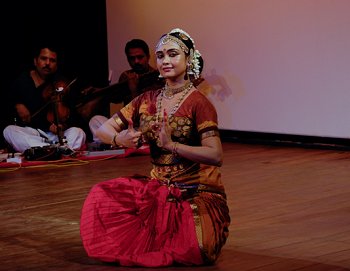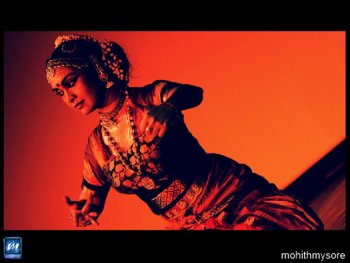
|   |

|   |
A unique dance production Lankalakshmi by Rajashree Warrier - Satish Suri e-mail: satishism@yahoo.co.in August 10, 2011  Lankalakshmi, a
choreographic adaptation of the iconic play by CN
Sreekantan Nair was presented by Rajashree Warrier under
the aegis of the Indian Council of Cultural Relations in
collaboration with the National Gallery of Museum and Art,
Bangalore. Lankalakshmi, a
choreographic adaptation of the iconic play by CN
Sreekantan Nair was presented by Rajashree Warrier under
the aegis of the Indian Council of Cultural Relations in
collaboration with the National Gallery of Museum and Art,
Bangalore.The play was presented as a thematic dance solo recital about the role play of Ravana. The mythic hero here is represented purely as a human Ravana, whose personal shortcomings lead to the destruction of his state. Rajashree’s Lankalakshmi brings to limelight, the varied traits of Ravana as a father, husband, brother, patriot, a devotee of Siva, a connoisseur of the arts. Her creativity manifests itself in the technique she employed in the narration and unfolding of events leading to the crumbling of Lanka. She delineated the common frailities of the human through the skilful use of navarasas. Love and lust, doubts and fears, anger and vengeance and the battle between good and evil within every human mind lead to clashes and conflicts outside. Rajashree’s interpretation of the play is in solo dance style in which one performer portrays all the characters. She essayed the several roles of Ravana, Hanuman, Rama, Sita, Lakshmana, Surpanaka and Vibhishana with consummate ease capturing the vivid emotive quality and aesthetics, including her costume which gave her a sense of grace and dignity. Her choreography set forth to evolve a cultural language combining the elements of dance, theatre, text and music, interpreting and articulating an ancient theme in a unique technique of narration, unifying the divine, the demonic and human dimensions.  The performance
began with an invocation to Lord Ganesha – Bhaja Manasa
Vighneswara. The performance
began with an invocation to Lord Ganesha – Bhaja Manasa
Vighneswara.With a swirl of the body, Rajashree entered the stage portraying the character of Hanuman, who enters Lanka to behold the splendour of Lanka and Ravana. As the narration unfolds, Rajashree brilliantly showcases her talents as she portrays each individual character, establishing a clear identity of each character through pure dance interludes and vibrant dramatic scenes like Surpanaka’s plight, Sita’s abduction, the turmoil of Ravana as he dreads his doom, the death of Kumbhakarna, Ravana’s confrontation with his own brother in the battle field, Mandodari consoling Ravana, the lament of Ravana over the killing of Indrajith, Ravana’s devotion to Siva as he performs pooja, his predicament over the death of Mandodari and Ravana’s journey to the battlefield. Skillful use of abhinaya by the artiste added elegance and eloquence to the performance. The narration ends after the fierce battle between Rama and Ravana, with Rama and Sita all set to return to Ayodhya. Excellent support was provided by the musicians Reju Narayanan (vocal), Nilambur Suresh (nattuvagam), Srikanth Tripunithara (mridangam), Thirunallar Ajith (violin) and V Soundarajan (veena) who enriched the performance with soulful music in spite of sound glitches. |